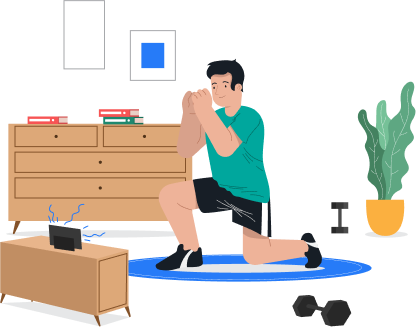Struggling to stay consistent with exercise? This article offers proven tips on how to stick to your workout routine and hit your fitness goals.
Learn how to set realistic goals, keep your plan flexible, and stay motivated.

Key Takeaways
- Identify your motivation for exercise to strengthen commitment and focus on your personal fitness goals.
- Set realistic and achievable goals, track progress, and celebrate achievements to maintain consistency in your overall health.
- Create a flexible exercise plan that incorporates a variety of activities, allowing for adjustments and keeping your routine interesting.

Understand Your Motivation
Identifying your motivation is the first step toward making exercise a habit. Pinpointing personal reasons for fitness like weight loss, heart health, or simply having more energy can keep you focused and dedicated.
Knowing why you want to exercise helps guide you toward a healthier lifestyle and strengthens your commitment. It’s not just about the physical benefits; knowing your “why” helps in staying motivated even when the going gets tough.
Consider what motivates you. Is it healthy aging, better sleep, or more energy? Perhaps it’s the confidence boost from achieving strength-building goals. Whatever your reasons, keep them front and center.
Consistent exercise routines also contribute significantly to better mental health and overall well being. When you understand your motivation, you’re more likely to stay on track and make exercise a lasting part of your life.

Set Realistic and Attainable Goals
Goal setting is crucial in your fitness journey. Start with small, manageable targets to build confidence and momentum. For instance, if weight loss is your goal, aim for 1-2 pounds per week instead of 20 pounds in a month. This makes the journey less overwhelming and more achievable.
Overly ambitious goals can lead to frustration and a higher likelihood of giving up. Knowing your current fitness level helps in setting attainable goals that promote progress without injury. Realistic goals are the foundation of a consistent workout routine. They provide direction and purpose, helping you maintain consistency and stay motivated.
Some people like to use specific goal setting theories. The SMART criteria—Specific, Measurable, Achievable, Relevant, Time-bound—provides a clear pathway for progress.
Achievable goals based on SMART criteria help you track progress and maintain regularity. Whether it’s running a 5K, lifting weights, or fitting into your favorite jeans, setting specific, measurable, and time-bound goals can make all the difference. This structured approach ensures you’re on the right track and makes exercise a rewarding part of your daily routine.

Create a Flexible Exercise Plan
Flexibility in your workout planning is key to maintaining a regular routine. Life is unpredictable, and having a rigid workout schedule can lead to frustration. Instead, create a flexible exercise plan that can adapt to different schedules and energy levels. This way, you can still fit exercise into your day, even when things don’t go as planned.
Incorporate a variety of physical activities to keep your routine interesting and engaging. Whether it’s basketball, racquet sports, a brisk walk, swimming, or performance training, mixing up your workouts can prevent boredom and keep you motivated.
Regularly monitor your fitness activities and make informed adjustments based on your performance and other factors. This approach ensures that your exercise program remains effective and enjoyable.
A flexible exercise plan not only keeps things fresh but also helps you stay committed. Allowing room for changes and incorporating various workouts helps maintain a consistent routine that fits your lifestyle.

Schedule Your Workouts
Treat your workouts as important appointments. Scheduling them on a calendar can enhance your commitment and make exercise a prioritized activity. Design a workout schedule that fits into your daily life, finding times when you are most energetic. This reduces excuses and helps you stay on track with your fitness routine.
Keep your workout plan visible on a calendar to foster accountability. Seeing your scheduled workouts can serve as a reminder and motivate you to stick to your plan.
Plan your workouts at times when you have the most energy and prepare your workout gear in advance. This small step can significantly impact maintaining a consistent exercise habit.
A well-planned workout schedule prevents burnout and helps you achieve your fitness goals. By treating your workouts as important appointments, you can stay consistent and make exercise a regular part of your routine.

Track Your Progress
Monitoring your progress is useful for staying motivated and consistent. You can use tools like fitness trackers, a fitness app, Excel, or workout journals to log your activities. This practice reveals patterns, areas for improvement, and boosts motivation by acknowledging small wins. Viewing your progress on paper or a screen provides a sense of accomplishment and keeps you motivated.
Logging your activities also offers insights into your physical strength and endurance. It helps you see how your body responds to different workouts and make necessary adjustments.

Find an Accountability Partner
Having an accountability partner can significantly improve your chances of sticking to a workout regimen. Teaming up with a friend, joining a social group, or getting an accountability coach can boost your commitment through mutual encouragement. Working out with someone who shares similar fitness goals can make exercise more enjoyable and less of a chore.
If your friends are not interested, consider using community resources to find workout partners. Working out with friends or family can boost motivation and provide essential support. Group exercises increase accountability and reduce the chances of skipping workouts.
Choose a workout partner who brings joy to your exercise experience to increase the likelihood of regular attendance.

Mix Up Your Routine
Regularly changing your workout can prevent performance plateaus and keep muscles engaged. Introducing variety to your routine can renew enthusiasm and make exercise less of a chore. Mixing up workouts helps in refreshing routines and preventing boredom.
Trying new exercises introduces your body to different movements, promoting balanced muscle development and other health benefits. Varying workouts minimizes the risk of overuse injuries by preventing repetitive strain.
Integrating different types of exercises, like cardio, moderate intensity exercise, and strength training, can enhance overall physical fitness and keep workouts interesting.

Incorporate Mini Workouts
Shorter exercise sessions can help maintain consistency and achieve goals, especially if you’re very busy. Brief, manageable bouts of activity throughout the day can be as effective as longer sessions.
Utilizing community resources, like local parks and recreation programs, can provide cost-effective exercise options. Mini workouts keep you active and boosts energy levels without spending hours at the gym.

Reward Yourself
Implement a reward system to celebrate milestones in your fitness journey. Consider rewards like hot baths, favorite meals, movies, or new workout gear.
Set clear milestones such as consistent gym attendance each month. Associating positive experiences with exercise makes you look forward to your fitness routine.
Rewards for your hard work can boost inspiration and help you stay committed. It’s essential to recognize and celebrate your achievements, no matter how small, to maintain a positive and motivated mindset.

Prioritize Rest and Recovery
Recovery is as vital as exercise. Muscles need time to repair and strengthen, making rest crucial. Tailor the frequency of rest days to individual needs and workout intensity. Active recovery exercises, such as low-intensity activities, enhance blood circulation and aid muscle repair.
Nutrition plays a vital role in recovery, replenishing muscle energy and supporting healing. Sleep is essential for muscle repair and overall performance, affecting energy levels and recovery quality.
Listen to your body to recognize when to take a rest day for recovery. Rest days enable you to return stronger for your next session.

Overcoming Common Barriers
If you have a tight schedule, you can include exercises at home or at work, like walking or climbing stairs. Overcome low energy by scheduling activities when you feel most energetic. Tackling obstacles like job responsibilities, family duties, and social engagements is key to maintaining consistency.
Acknowledging common barriers like low self-confidence, discomfort, and lack of time helps in developing effective solutions. Minimizing distractions, like preparing workout clothes the night before, especially if you’re not a morning person, can improve adherence to an exercise routine.
Beginning with activities you enjoy can help combat low self-confidence and gradually increase your fitness.

Make Exercise Enjoyable
Choosing enjoyable physical activities significantly boosts the likelihood of maintaining a consistent habit. Incorporating activities like yoga or swimming can enhance adherence to an exercise plan and target different muscle groups.
Pairing enjoyable activities with workouts, like listening to music or chatting with friends, can greatly enhance the regular exercise experience.
Exploring alternatives like outdoor running or other enjoyable activities can make exercise feel less like a chore. Finding joy in your workouts is key to staying consistent and making exercise a permanent part of your lifestyle.

Summary
Staying consistent with exercise requires understanding your motivation, setting realistic goals, and creating a flexible plan. Tracking your progress, finding an accountability partner, and mixing up your routine can keep you motivated and engaged. Incorporating mini workouts, rewarding yourself, and prioritizing rest and recovery are essential strategies to maintain consistency.
Overcoming common barriers and making exercise enjoyable can transform your fitness journey into a rewarding experience. Apply these tips and strategies to achieve your fitness goals and enjoy the numerous benefits of a consistent exercise routine.

Frequently Asked Questions
How can I stay motivated to exercise regularly?
Staying motivated to exercise regularly boils down to knowing why you’re doing it and setting achievable goals. Consider tracking your progress and teaming up with an accountability partner to keep you inspired!
What are SMART goals in fitness?
SMART goals in fitness are Specific, Measurable, Achievable, Relevant, and Time-bound, helping you stay focused and track your progress effectively. By setting these goals, you’ll see clearer results and maintain motivation.
How can I fit exercise into a busy schedule?
You can easily fit exercise into a busy schedule by incorporating shorter workouts throughout the day and scheduling your workouts for when you feel most energetic. Planning ahead makes it even simpler!
Why is rest and recovery important in a fitness routine?
Rest and recovery are crucial because they enable your body to heal and grow stronger after workouts, helping to prevent injuries. So, don’t skip them if you want to optimize your fitness routine!
How can I make exercise more enjoyable?
To make exercise more enjoyable, pick activities you love, listen to music while working out, and try different workouts outside the typical gym setting. You’ll find that staying active can be a lot more fun when you mix things up!

